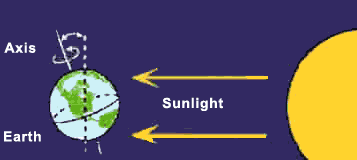BACKGROUND:
A season is one of the four periods of the year
including spring, summer, autumn, and winter. Seasons are defined in two
ways. Climatic seasons reflect changes in temperature, weather, and the
length of daylight. The length of climatic seasons varies, for example at
high northern latitudes winter is relatively long and summer is relatively
short.
|

Summer in the Southern Hemisphere,
winter in the Northern Hemisphere
|
Astronomical seasons are defined by the position of
the Sun with respect to the Earth. Because the Earth’s rotational axis is
tilted 23.50, the overhead position of the Sun changes throughout
the year. The Sun appears to migrate more overhead in summer, and less so in
winter. For the Northern hemisphere, the astronomical summer begins on the
summer solstice, which is the day the Sun reaches its most northern, most
overhead position. As the Sun moves back south, it comes directly over the
equator. This marks the autumnal equinox, or the start of astronomical
autumn. When the Sun reaches its southernmost point below the equator, it is
the winter solstice, or the start of the winter season. Finally, as the Sun
moves back north, it again crosses the equator. This is the vernal equinox,
and the start of spring.
The climatic seasons correspond to the astronomical
seasons because the Northern hemisphere is warmed when it is close to the
summer solstice, because the Sun is more directly overhead. Likewise, the
Northern Hemisphere grows cool as the Sun moves south, and the seasons
transition through fall and into winter.
PROCEDURE:
- Show the students pictures or slides of the Earth as seen from space.
Point out the clouds, oceans, and land.
- Show the inflatable globe to the class. The globe shows the oceans and
land masses. Have them find the general area where they live.
Point out that the globe is tilted, and explain that this is because
the Earth is tilted on its axis relative to the Sun. Explain how this
causes the seasons. Some students may notice that when the northern
hemisphere tilts away from the Sun, the southern hemisphere tilts toward
the Sun. Explain that our summer season is the winter season in the
southern hemisphere.
 In the
following activity, the students will demonstrate that the Earth is
rotating by watching changes in shadows cast by the Sun. Go outside to
the playground, and have the students find the shadow cast by a pole. If
many shadows are available, divide the class into groups. Have the
students outline the shadow, or a portion of it, with chalk. Record the
time. Come back in one or two hours. Have the students mark where the
shadow is now located. Explain that the shadow has moved because the
Earth has turned (rotated) while the Sun has stayed in the same place. In the
following activity, the students will demonstrate that the Earth is
rotating by watching changes in shadows cast by the Sun. Go outside to
the playground, and have the students find the shadow cast by a pole. If
many shadows are available, divide the class into groups. Have the
students outline the shadow, or a portion of it, with chalk. Record the
time. Come back in one or two hours. Have the students mark where the
shadow is now located. Explain that the shadow has moved because the
Earth has turned (rotated) while the Sun has stayed in the same place.
Ask the students if they think shadows help us tell time. They may
make the connection between the passage of time and the movement of the
shadow, and answer yes, which is correct. Explain again that because the
Earth is rotating, the shadows change position (this is how sundials
work).
- Ask the students where the Sun comes up every morning. They should
have the sense that it always rises in the east. Ask them about sunset.
Again, they may know that the Sun sinks in the same general area all the
time. Explain that in reality, it is not the Sun that moves, but the
Earth. As the Earth rotates toward the Sun, we experience sunrise, and
as it rotates away, we experience sunset.
|